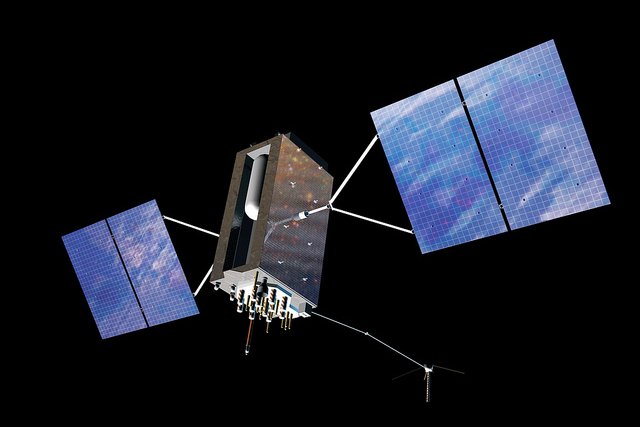1 of 2 | An artist's rendering of a new GPS III satellite, which is expected to be the most advanced, secure version of the system launch yet by the U.S. Air Force. Photo courtesy of Lockheed Martin
Sept. 20 (UPI) -- Lockheed Martin and the U.S. Air Force are preparing to launch the first of their constellation of advanced GPS III satellites in December, expected to be the most precise, reliable version of the system yet.
While civilians and businesses around the world depend on GPS for everyday communications and navigation, the military requires constant location information transmitted through a system secure enough to be impenetrable to enemies. The new system is built for modern electronic warfare, officials say, which will protect it for all users.
"The world is dependent on GPS, from getting directions to getting cash from an ATM or trading on the stock exchange," Secretary of the Air Force Heather Wilson said in a press release. "These satellites will provide greater accuracy and improved anti-jamming capabilities, making them more resilient."
The initial satellites for the GPS system were launched by the Air Force in 1978 and, with the help of upgrades during the last three decades, the system has become a virtual requirement for modern life.
The majority of the current system is made up of Lockheed Martin-manufactured IIR and IIR-M satellites. The company is under contract for 10 next-generation GPS III satellites, which are at various points of construction, and this week was awarded a $7.2 billion contract by the Air Force for 22 GPS IIIF follow-on satellites expected to be available for launch by 2026.
"We're grateful for the U.S. Air Force's continued confidence in Lockheed Martin on the GPS III/IIIF program," Jonathan Caldwell, GPS III program manager for Lockheed Martin, told UPI. "We've worked hard to develop and produce GPS III to help the Air Force modernize the GPS constellation with new, more powerful, and more resilient, technology."
The first of the initial 10-satellite GPS III constellation was declared ready for launch in September 2017 and in August was shipped to Cape Canaveral, Fla., for its eventual launch this December. The second satellite was declared ready for launch in August, and is scheduled to be launched in 2019.
Five more of the satellites are in various stages of construction and assembly, and Lockheed has said it has acquired the parts for construction of the rest.
Better and more reliable
The GPS III system "will be the most powerful and resilient GPS satellite ever put on orbit," Chip Eschenfelder, communications lead for military space at Lockheed Martin, told UPI.
The system will have "three times greater accuracy, eight times improved anti-jamming capability and a new civil signal compatible with other international navigation satellite systems, like Europe's Galileo," Eschenfelder said.
While preventing civilian users from descending into "searching for signal" purgatory, the system is designed and built for the military -- though military-level protection will bring benefits for everybody who uses it.
The new satellites will have anti-jamming systems as part of the system's Regional Protection Capability. The systems are meant to ensure access to GPS signals by U.S. and allied military forces in the face of hostile electronic warfare efforts, Eschenfelder said.
The GPS IIIF satellites will feature a fully digital navigation system, with 70 percent of the first 10 planned already 70 percent digital. They will also mount a laser retro-reflector array to confirm each satellites position in orbit to enhance signal accuracy.
The GPS III and GPS IIIF will mount search-and-rescue payloads that will allow for better disaster response geolocation efforts. And the system has a new L1C civil signal that will make it compatible with other international GPS systems, like the European Galileo system under development, Eschenfelder said.
The constellation, when fully completed, will be available to more than 4 billion users worldwide.















